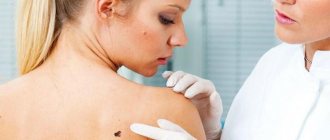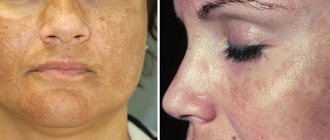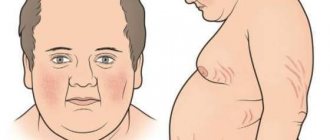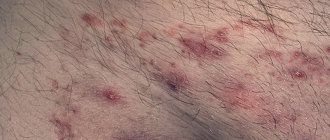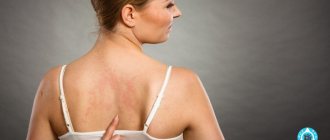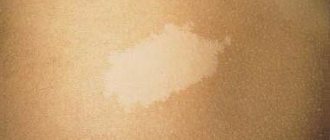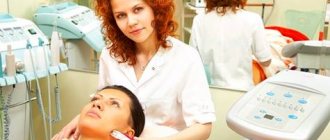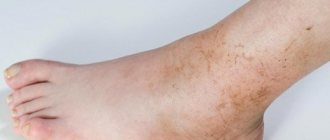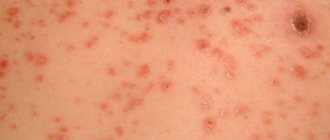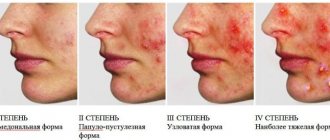Development of dry patches on the skin
Typically, dry spots form on the body suddenly and become an unpleasant surprise for a person. Many people do not pay attention to these skin formations and hope that the pathological condition is temporary and not serious. In fact, dry patches should not be ignored, as they can warn of the development of diseases. What spots signal unfavorable processes in the body? You need to pay attention to the following formations:
- Actively increasing in size;
- Intensely itchy and flaky;
- Constantly appearing in the same area of the body;
- Long lasting;
- Accompanied by pain;
- Transmitted from a sick person to surrounding people;
- Bursting with the formation of ulcers, weeping wounds, cracks.
Causes of dry spots
The reasons for the formation of dry spots on the skin are very different. Skin formations develop under the influence of both endogenous and exogenous factors.
- Allergy. The most common cause of various skin pathologies. Allergic dermatitis occurs after skin contact with an irritant. To eliminate an allergic reaction, it is enough to get rid of the allergen.
- Mycosis. Fungal skin infection. The disease is difficult to treat and can become chronic.
- Stress. Dry spots on the body are the consequences of stressful situations, experiences, mental disorders, and emotional turmoil.
- Uncomfortable climatic conditions. In winter, the skin dries out and becomes stained due to icy winds, frost, and heating devices in the home. In summer, the skin rarely dries out, mainly due to overheating in the sun.
- Dermatological pathologies. A large list of skin diseases provokes the formation of dry spots on the body.
- Endocrine pathologies. Dry spots can occur due to dysfunction of the thyroid gland.
- Diseases of the digestive system. A person’s appearance directly depends on the health of the gastrointestinal tract. If the digestive system is sick and does not work properly, then the condition of the skin worsens.
- Avitaminosis. With a lack of vitamins and minerals in the body, with poor and poor nutrition, the skin is in poor condition.
- Autoimmune diseases. When the functioning of the immune system is disrupted, antibodies are synthesized in excess quantities and begin to attack the body's own cells, including skin cells. As a result, not only pathological formations appear on the body, but tissue necrosis may also develop.
- Impact of cosmetics. The skin becomes irritated and dried out when using inappropriate or low-quality cosmetics and care products.
- Photodermatitis. Negative reaction of the skin to ultraviolet solar radiation. The pathology is accompanied by drying out of the outer skin layer, impaired melanin synthesis, and the appearance of flaky spots.
Causes of dry skin on thighs and buttocks
Dry skin is a sign of thinning lipid film.
The surface of healthy skin is covered with a thin lipid film, which protects the stratum corneum from damage and prevents the loss of moisture necessary for metabolic cellular processes. If the lipid layer becomes thinner or compromised, water begins to quickly evaporate from the surface of the skin, making it dry and sensitive. The reasons why the protective layer of the skin is damaged can be divided into two groups: external and internal.
External reasons
External causes of dry skin on the thighs and legs include:
- Climatic conditions and indoor microclimate. High temperatures combined with low humidity outdoors or indoors, as well as low temperatures in winter, can cause increased evaporation of moisture from the skin, and, as a result, dryness.
- Exposure to household chemicals and improper care. Frequent taking of hot baths, the use of aggressive peelings, soaps, shower gels in combination with neglect of moisturizers leads to disruption of the natural lipid layer of the epidermis. Dryness can also be a result of contact with fabric that retains traces of washing powder or other detergents.
- Clothes made from low-quality fabrics. Rough, synthetic or chemical-impregnated fabrics or constant friction from clothes of the wrong size can also cause disruption of the barrier function of the upper layers of the skin.
- Aggressive exposure to ultraviolet radiation due to excessive sunbathing and visiting a solarium.
Internal reasons
Internal causes of peeling skin on the thighs are:
- Dehydration. Failure to comply with the drinking regime, digestive disorders, high body temperature, repeated vomiting and diarrhea, excessive consumption of drinks containing caffeine, create a lack of moisture in the body, and, in particular, in the upper layers of the skin.
- Hypovitaminosis. Deficiency of vitamins A, E, D is one of the most common causes of dry and tight skin.
- Hormonal changes and disorders. Violation of the protective functions of the skin can be a symptom of hypothyroidism, diabetes mellitus, and also manifest itself during pregnancy and menopause in women.
- Vascular diseases and diseases of the central nervous system. Pathologies leading to vascular spasms and disruption of innervation may cause insufficient blood supply and nutrition to the skin.
- Allergic and autoimmune reactions such as eczema, psoriasis, neurodermatitis, atopic dermatitis in infants and young children.
- Infectious diseases, including parasitic and fungal diseases.
- Smoking and alcohol cause circulatory problems not only in the internal organs, but also in the outer layers of the skin.
Dry white spots
There are several reasons for the formation of dry white spots.
In most cases, light skin formations occur due to impaired melanin synthesis in certain parts of the body. This pathology is usually a consequence of excessive exposure to direct sunlight.
Ultraviolet radiation from the sun negatively affects the condition of the skin; under its influence, the outer layer of the epidermis dries out and peels off. The absence of melanin pigment in specific areas of the body is called vitiligo.
Also, white spots are a sign of a fungal infection on the skin. Most often, white skin formations are a symptom of lichen. The lichen spot has a clear edge, is covered with scales, and peels off intensely. Often, fungal scaly spots itch unbearably. Treatment for a fungal infection is long and grueling, and the disease can recur.
Dry red spots
Most often, red spots form on the skin; they are caused by exposure to an irritating factor, mainly an allergen.
Allergic rashes affect large areas of the body and are accompanied by itching and inflammation of the skin. Red dry formations are a symptom of shingles.
This viral disease, accompanied by severe pain on the skin, is often diagnosed in people who have had chickenpox, are exposed to constant stress, and have nervous disorders. Spots in this disease usually form on only one side of the body and are located in the area where the nerve trunks lie.
Red, scaly spots are a sure sign of psoriasis. This chronic non-infectious disease, presumably of an autoimmune nature, is very difficult to cure. Also, red spots may appear when the skin is exposed to sharp wind and cold. Such formations are not dangerous; they simply indicate drying out of the skin. It’s not difficult to get rid of them; just treat the skin with mild moisturizers.
Treatment of plaques on the legs
Depending on the cause of the disease that caused the appearance of plaques on the legs, the set of therapeutic measures will differ. Infectious pathology requires the use of antibiotics, trophic disorders require complex treatment, diabetes requires the use of insulin.
If the plaques on the legs itch, antihistamines and hormonal drugs may be additionally prescribed. The former suppress itching and help reduce histamine activity.
Hormonal products for external use (ointments and creams) effectively eliminate the unpleasant symptom and speed up recovery. They should only be prescribed by a doctor. Self-medication with this group of medications can cause the development of unpleasant side reactions and complications.
Dry dark spots
Dark brown and black spots on the body can be both harmless areas of excess pigmentation and harbingers of cancer.
Dark spots on the skin are often observed in pregnant women. In this case, there is no need to worry. Increased pigmentation and slight peeling of the skin during pregnancy is a normal phenomenon that accompanies hormonal changes in the body. After childbirth, skin pigmentation returns to normal.
The appearance of deep brown spots is one of the signs of natural aging of the skin. In older people, excess skin pigmentation is a normal and frequently observed phenomenon. If a dry brown skin lesion is very itchy, it may be a sign of a fungal skin infection. In any case, if dark spots appear on the body, it is better to be examined by a medical specialist to exclude the development of melanoma.
In children
Typically, dry patches in a child occur due to infections. These include the following:
- measles – caused by measles bacteria and is extremely contagious. Dangerous with its complications. In addition to the red rash on the body, the temperature rises, the throat becomes red and sore, patients complain of weakness and runny nose;
- rubella - in children the pathology occurs in a mild form. An acute viral infection characterized by a red rash. The spots are smooth, diameter 5-10 mm, localized on the face, buttocks or lower back;
- diaper rash - bright red and painful blemishes. Dry spots on the skin of a baby appear in the groin folds, armpits, and neck. At the initial stage they are dry, but if left untreated they may become covered with blisters and then crust.
Drug therapy
If suspicious spots occur, you should go to a dermatologist.
Before recommending treatment, the doctor must find out what kind of pathology it is and what factors it is caused by. To make an accurate diagnosis, in most cases it is enough for the doctor to examine the skin formation and collect an anamnesis. If the dermatologist is not sure of the diagnosis, then he conducts a laboratory analysis of a scraping of the affected area of the skin.
How to treat skin affected by dry spots? The choice of medications is determined by the cause of the pathological condition. Listed below are the medications most often prescribed to relieve dry skin lesions in certain diseases.
- Antihistamines. Used for allergic reactions, relieve inflammation of the skin. The drugs Tavegil, Suprastin, Claritin are usually prescribed. For treatment to be successful, it is necessary to avoid contact with allergens.
- Sedatives. They are used if the appearance of spots on the skin is provoked by worries and constant stressful situations. A sick person is recommended to consult a neurologist. Usually in this case, doctors prescribe sedative tablets to patients: Persen, Tenoten, Novo-Passit. Drinking mint tea is also beneficial.
- Anti-inflammatory ointments. If the affected skin is inflamed and very itchy, then hormonal-containing external agents are used. The most commonly prescribed ointments are Hydrocortisone, Flumethasone, Betamethasone. Non-hormonal preparations can also be used to remove stains: Salicylic, Tar, Zinc ointment. Bepanten cream can be used to treat young children.
- Hepatoprotectors. Prescribed if skin rashes are caused by disruption of the digestive system. Carsil tablets and Essentiale capsules are usually used. Enterosgel and activated carbon are suitable for removing toxins from the body.
- Analgesics. If skin formations are accompanied by intense pain, then painkillers and non-steroidal anti-inflammatory drugs are prescribed: Nurofen, Ketorol.
- Antibiotics. They are prescribed if the spots are a symptom of a bacterial infection of the skin.
If the appearance of dry spots is caused by an internal disease, then the underlying pathology must be treated. In this case, therapy is determined exclusively by a medical specialist. The dosage and duration of use of the medicine depend on the age and well-being of the patient.
It is strictly forbidden to remove stains from your child’s skin on your own. The baby needs to be taken to the pediatrician urgently. The doctor will determine the cause of skin rashes on the child’s body and prescribe effective and safe treatment. Many children develop skin spots as a result of food allergies.
Recommended reading:
Brown spots all over the body;Causes of white spots on the skin;
Blue-violet spots on the skin -.
Cosmetology procedures
The removal of dry spots caused by exogenous factors is carried out by specialists in cosmetology clinics. If skin formations are caused by psoriasis, eczema and other endogenous causes, then cosmetic procedures can only be performed with the permission of the attending physician. To remove dry stains, use the following procedures.
- Laser therapy. The safest and most gentle way to remove stains. Laser beams have a destructive effect on melanin, causing dry dark formations to burn. During the procedure, normal skin tissue is not damaged. If the dark spot is large, then the operation must be repeated several times.
- Chemical peeling. Rejuvenation and elimination of skin imperfections by removing the upper layers of the skin. The spots are burned with acids: tartaric, hydroxysuccinic. The burned area of the epidermis peels off, leaving healthy skin in its place.
- Light therapy. The affected parts of the body are exposed to artificial light rays of different lengths. This therapy is used for psoriasis, eczema, and vitiligo.
In cosmetology clinics, doctors sometimes advise patients to use special creams with a whitening effect. These external medications contain effective and safe substances: arbutin, hydroquinone, ascorbic acid.
Folk remedies for dry spots
Natural remedies help fight dry spots quite effectively. But before you treat yourself at home with medications suggested by traditional medicine, you should definitely consult a doctor. The best folk recipes are listed below.
- Camomile tea. Helps dampen the inflammatory response. Take dried chamomile. A tablespoon of plant material is poured into a liter of hot water. The solution is infused for about 20 minutes. The prepared infusion should be used to treat the affected skin daily until the spots completely disappear.
- Honey mask. Effectively removes dry spots. Two tablespoons of natural honey are melted in a water bath. A tablespoon of village cottage cheese is added to the honey mass. The products are thoroughly mixed until smooth. The prepared mask is applied to the affected area of the face, left on for 30 minutes, and washed off.
- Olive mask. Olive oil and natural honey are mixed in equal parts. The products are thoroughly mixed. The mask is applied to a previously washed face, left on for 30 minutes, and washed off. After the procedure, it is recommended to treat the skin with a moisturizer.
- St. John's wort decoction with mustard. An effective remedy for the treatment of psoriasis. Dried St. John's wort is taken. A teaspoon of plant material is poured into a glass of hot water. The solution is placed on low heat and cooked for about five minutes. A small amount of mustard powder and butter is added to the finished broth. The resulting medicine should be lubricated on the affected areas of the body once a week.
- Herbal baths. Therapeutic baths based on medicinal plants help disappear dry spots. A bath with the addition of a decoction of string is a good cure for skin rashes. It is recommended to take it twice a week. You can also make a bath using bay leaf infusion. You should take this bath for 20 minutes twice a week.
Traditional medicine helps to cope only with those spots that are caused by exogenous factors. If the causes of the appearance of skin formations are pathologies of the digestive system, nervous disorders, infectious diseases and other endogenous factors, then it is useless to use folk remedies.
What can a plaque on the skin of the leg lead to?
If plaques appear on your legs, then you should definitely consult a doctor. This could be a simple insect bite, a burn mark, or a serious infectious pathology (Lyme disease). Delaying a visit to the doctor can cause the patient’s condition to worsen.
The doctor will conduct an appropriate examination. Determines the cause of a specific pathology. Offer treatment options. Sometimes it is necessary to use specialized tests to verify the diagnosis. In some cases, a skin biopsy is performed.
